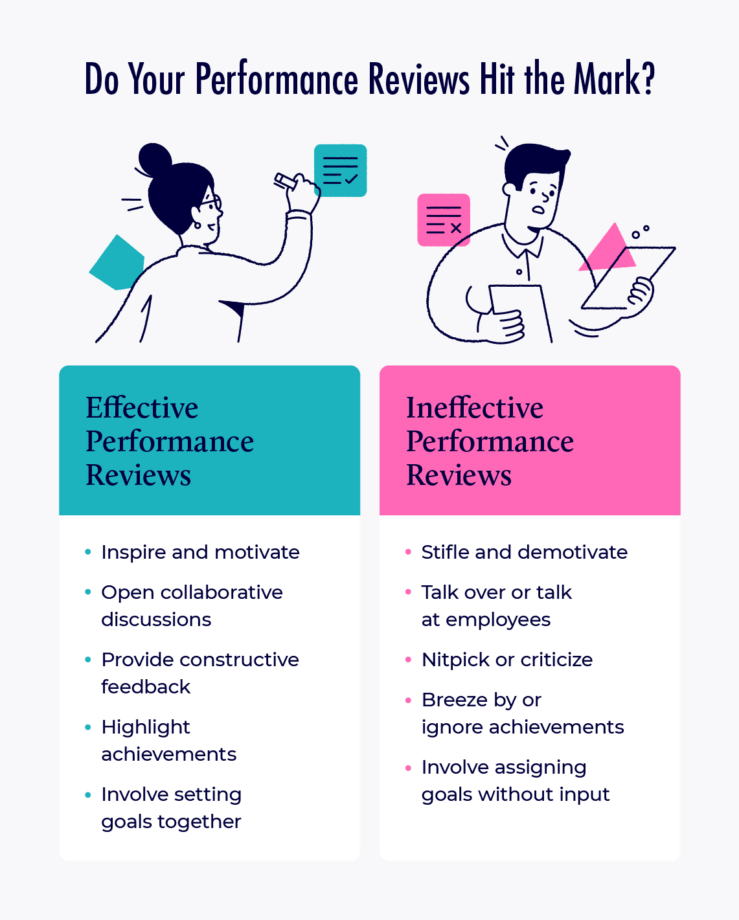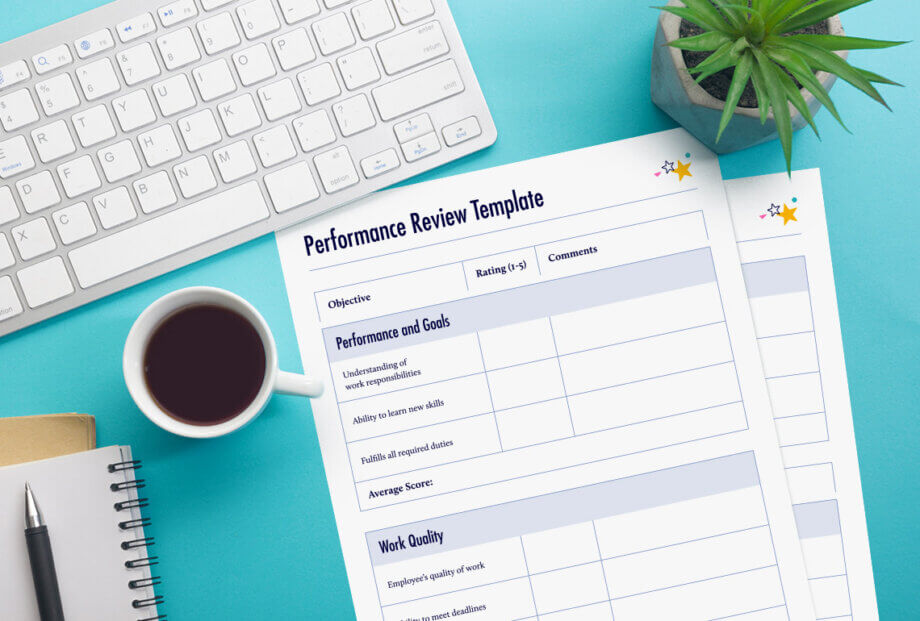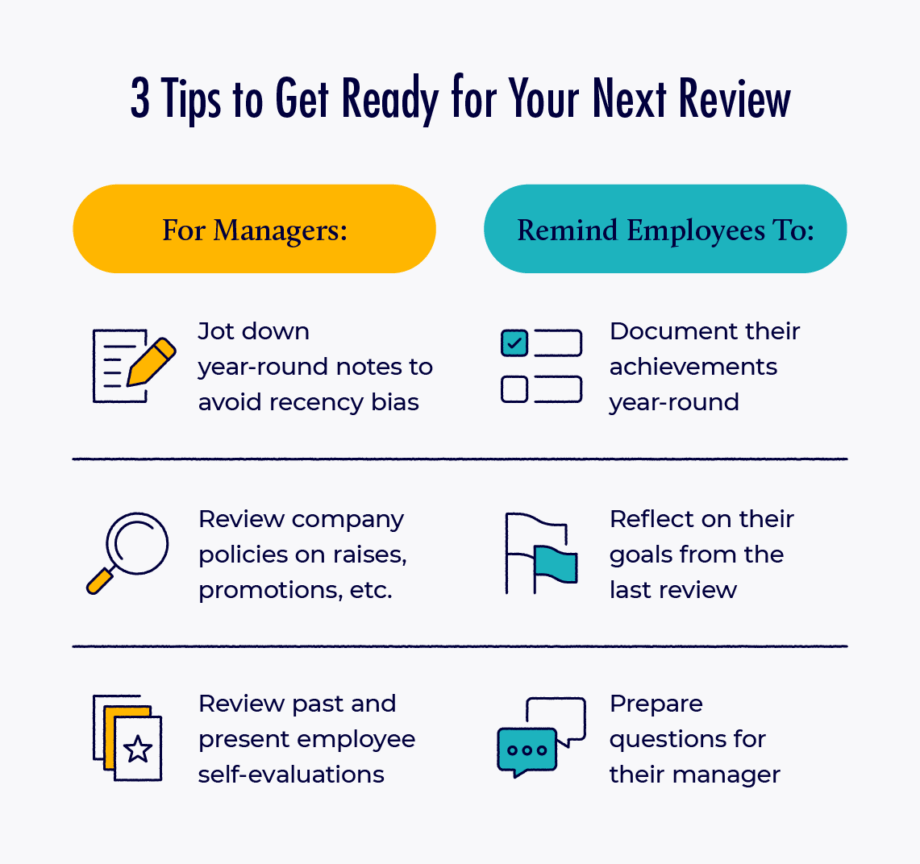Performance reviews tend get a bad rap from both employees and managers alike.
Managers often dread preparing them, and employees often dread receiving them.
But this shouldn’t (and doesn’t have to) be the case!
Performance reviews are an essential part of strategic development for your employees. An intentional and thoughtful review is one of the best ways to correct poor behavior and build confidence for future work.
Unfortunately, most reviews lack depth, substance or actionable takeaways, leaving the employee confused about what they do well and how they can grow personally and professionally.
You’re here to learn how to prepare and deliver a great performance review, and I’m here to tell you I’ve got you covered. I’m going to share all my knowledge and insights with you today from my numerous years of delivering and refining effective reviews.
(You can even snag my own personal performance review template to make things easier!)
Ready? Let’s get started!
Key Takeaways
- Typical reviews make employee performance worse one-third of the time. That stings, and you don’t have to contribute to that statistic! (Kluger, DeNisi, 1996)
- About one-third of employees want to receive continuous, face-to-face feedback rather than annual reviews. (Joblist, 2019)
- Use my customizable performance review template to have more personal, frequent and effective performance reviews.
What Is a Performance Review?
Performance reviews should inspire and motivate employees toward personal and professional growth. When done well, they energize employees to do their best, most meaningful work.

The best way to think of performance reviews is a two-way conversation. These conversations should celebrate achievements, identify challenges and facilitate growth with actionable goals.
If done well, performance reviews build rapport between employees and managers — and align the team on the company’s most important goals.
What to Include in a Performance Review Template
Templates guide your conversation during reviews. Since you’ll cater performance reviews to each individual on your team, no two review templates will look exactly alike — but they will share a common set of principles and sections.
I like to organize my performance reviews in two categories: Recap & Feedback and Looking Ahead.
Recap & Feedback takes a look at what happened over the review period and shares feedback where needed.
Looking Ahead gives an overview of what to expect in the upcoming review period and how you can excel in your role.
Additionally, your performance review template should:
- Have sections of interest with two or three objectives max. This encourages employees to have a laser-focus on top priorities.
- Have a clear measuring system. This could look like ranking your employees from 1 to 5 with a key that explains what each number stands for.
- Leave room for further comments on each objective. This is where you and your employee can discuss rankings with clear examples.
- Display an overall employee rating. This helps show where employees shine and where they need coaching.
If you don’t have a performance review template yet, no worries. Feel free to steal mine!
(It’s even editable, so you can quickly and easily customize it to each team member)

Let’s take a look at each section of my performance review template.
1 . Performance and Goals
Great leaders and managers prioritize results over action.
Is the employee hitting milestones and goals, or are they just kicking the can down the road, marking off tasks but not getting anything meaningful done?
You need to let them know, and this is the section to do that.
Do they clearly understand what they are responsible for? Are they owning those responsibilities? Are they growing in their ability and capacity to do everything the role requires?
This ensures your employees understand their role and the expectations you have for it. After all, they can only “exceed” if they know what “exceeding” actually means.
Objectives need to center around their required duties, skills or goals that have been set.
Some objectives you might discuss with your team in this section include:
- Understanding work responsibilities
- Ability to learn new skills
- Fulfills all required duties
2. Work Quality
After establishing whether your employee knows and completes required tasks, open the conversation to how they complete them.
Are they completing tasks well ahead of time, or do they have a reputation for submitting work at the 11th hour?
Avoid vague discussions on “improving.” Be specific and communicate clearly on how they can improve the quality of their work.
Some objectives you might discuss with your team in this section include:
- Ranking your employee’s overall quality of work (use the comment section to clarify this rating with examples)
- Their ability to meet deadlines
- Their time management and productivity levels
3. Proactivity
Proactive employees find ways to eliminate roadblocks to get work done. This can be as simple as arriving at work on time or as ambitious as improving on a company process that’s not working.
They often utilize a concept I call UIHO: “Unless I hear otherwise, …”. This mindset removes roadblocks to accomplishing goals AND gives the boss an opportunity to change course.
Proactivity is a win-win situation for employees and businesses. It allows companies to operate at a high level and prepares employees to move into more complex roles where resourcefulness and independent thinking are required..
Some objectives you might discuss with your team in this section include:
- Giving adequate notice before taking time off
- Arriving to work and meetings on time
- Striving to bring new ideas forward
4. Leadership Potential and Initiative
As your business grows, you need employees to step up and take more ownership.
This section gives you the chance to identify leadership potential and offer coaching to develop employee talent.
Employees get the chance to present their case for desired promotions and share career goals.
It’s a prime opportunity for you to listen and the employee to be heard. Don’t skim over it!
Some objectives you might discuss with your team in this section include:
- Checking their work for quality and attention to detail
- Using creative problem-solving skills
- Fostering effective team collaboration
5. Feedback and Communication
Communication is oxygen in any company.
It’s also a key ingredient of a productive team.
While everyone has a different communication style, the ideal communication style while delivering a performance review is an assertive one.
This style is direct yet empathetic, which is necessary in order to be clear and understanding with your feedback.
Download My Free Performance Review TemplateBe clear and direct about what you expect (but stay empathetic). This section is where you often have the most productive dialogue around professional growth, so don’t waste it by being fuzzy or tone deaf!
The Do’s and Don’ts of a Performance Review
According to a recent Gallup survey, only 1 out of 5 employees agree they receive meaningful feedback at work. Ouch!
Yet on the bright side, it means providing thoughtful feedback during reviews can take your workplace leaps and bounds above the rest.
To make sure you’re providing your team with feedback that’s actually helpful, consider the “dos” and “don’ts” of performance reviews below as a helpful cheat sheet.
| Do | Don’t |
| Come prepared by tailoring the conversation to the employee | Use the same approach for every employee |
| Create a comfortable environment where you can have a two-way conversation | Rush the meeting by simply reading through the review |
| Focus on constructive feedback | Avoid the tough conversations |
| Point out the accomplishments of the employee | Only focus on the employee’s weaknesses |
| Actively listen during the review | Dominate the conversation |
| Set clear expectations and goals at the end of the reviews | Set unmeasurable or unrealistic goals |
Above all, try to remember that performance reviews are individual discussions, and you should tailor them to each employee’s needs.
How to Prepare for a Performance Review
Another important factor in having meaningful conversations during reviews is preparation — for both employees and managers.
As someone who’s been on both sides of the conversation, here are a few of my favorite preparation tips.

Preparing as a Manager
I get it. You’ve already got your hands full with all the day to day management tasks.
But let me tell you: of all the tasks assigned to you, delivering a great performance review is one of the highest leverage tasks you can do.
Reviews can lead to pivotal changes if employees feel listened to and encouraged — so don’t rush and take the time necessary to prepare a thoughtful, intentional review.
Some of my favorite ways to prepare for performance reviews include:
- Creating a notes document for reviews each year. Use it to jot down things you want to discuss in upcoming reviews to avoid recency bias (the tendency to only remember performance over the last three weeks).
- Review previous evaluations. This provides insight into if your team is making progress on previous goals or if they need more coaching.
- Gather feedback from other sources (peers, teammates, etc.). They interact with your team members differently than you — meaning they’ll likely notice things you don’t.
- Prepare your talking points. This way you won’t forget anything you’d like to discuss.
- Review company policies and procedures. Especially take note of those relating to raises, changes in responsibilities or promotions — your team may want to discuss these.
- Review employee self-evaluations. This will give you a starting point to base some of your conversation points around.
Preparing as an Employee
While employees are responsible for preparing themselves for reviews, giving them a push in the right direction with some gentle reminders is always helpful.
Here are some preparation tips you can give to employees to help them shine during their performance review. Advise them to:
- Reflect on the year they’ve had. Encourage employees to take notes on their performance throughout the year to have a more accurate recollection come review time. Encourage them to take off the rose-colored glasses and be honest in their assessments.
- Review their goals. Remind employees to determine whether they accomplished their previous goals, and if not, ask them to reflect on what got in the way.
- Document their achievements. Let employees know that you’d like to know about their proudest achievements.
- Identify areas for improvement. Remind your team that you don’t expect perfection but that you value those who can recognize their weaknesses and plan for improvement.
- Prepare questions for their manager. Let them know this can help them show up as an active participant in the conversation rather than a passive one.
- Complete their employee self-evaluation. This will guide performance review conversations, so remind them to include anything they’d like to discuss.
What to Do After an Employee Review
The review is only the first step in helping your team members learn and grow. To make the most of review discussions, encourage your employees to:
- Reflect on your feedback. Journaling daily can be a powerful tool to help employees understand what they need to work on.
- Ask for clarification. Remind them it’s okay to get back to you with any questions or comments they think of after reviews.
- Adjust or create new goals. Employees are more likely to complete goals if they have a hand in making them.
- Create an individual development plan. This acts as their roadmap for improvement until their next review cycle.
- Track their progress. This can be as simple as a document where they keep notes on their performance till the next review cycle, which can help them see their strengths and weaknesses for the next review period.
- Seek feedback throughout the year. Consistent feedback speeds up their growth.
- Learn and implement time management strategies. The more effective employees are with their time, the better their work performance will be.
- Prepare for the next review. Whether their goals involve communicating more effectively or hitting higher performance numbers, remind employees to get started as soon as possible to prepare for their next reviews.
Of course, remember to create your own management goals after employee performance reviews. You can only expect growth from your team members if you’re willing to grow yourself.
(And don’t forget to download a free copy of my performance review template!)
Here’s to becoming better leaders together,
Thomas







Leave a Reply